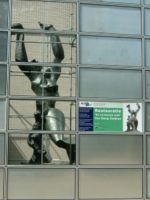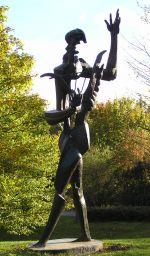- Ossip Zadkine
-
 Zadkine's well-known sculpture "The Destroyed City" (De Verwoeste Stad) in Rotterdam during renovation in 2005
Zadkine's well-known sculpture "The Destroyed City" (De Verwoeste Stad) in Rotterdam during renovation in 2005
Ossip Zadkine (Russian: Осип Цадкин; July 14, 1890 – November 25, 1967) was a Belarusian-born artist who lived in France. He is primarily known as a sculptor, but also produced paintings and lithographs.
Contents
Early years and career
Zadkine was born as Yossel Aronovich Tsadkin[citation needed] (Russian: Иосель Аронович Цадкин) in Vitebsk, Belarus, then part of the Russian Empire. His father was Jewish and had converted to the Russian Orthodox religion; his mother was of Scottish ancestry.[1]
After attending art school in London, Zadkine settled in Paris about 1910. There he became part of the new Cubist movement (1914-1925). He later developed his own style, one that was strongly influenced by African art.
Zadkine served as a stretcher-bearer in the French Army during World War I, and was wounded in action. He spent the World War II years in America. His best-known work is probably the sculpture "The Destroyed City" (1951-1953), represents a man without a heart, a memorial to the destruction of the center of the Dutch city Rotterdam in 1940 by the German Luftwaffe.[2]
Personal life
Zadkine married, in 1920, Valentine Prax (1899—1991), an Algeria-born painter of Sicilian and French Catalan descent. They had no children.
The artist's only child, Nicolas Hasle (born 1960), was the result his affair with a Danish woman, Annelise Hasle.[1] Since 2009, Hasle, a psychiatrist, who was acknowledged by the artist and had his parentage legally established in France in the 1980s, has been party to a lawsuit with the City of Paris to establish his claim to his father's estate.[2]
Zadkine died in Paris in 1967 at the age of 77 after undergoing abdominal surgery[2] and was interred in the Cimetière du Montparnasse. His former home and studio is now the Musée Zadkine.
Awards
Zadkine or his wife.also established a Musee Zadkine in the village of Arques in the Mid-Pyrenees region. It stands opposite a 12th century church that is itself of interest. Zadkine lived in Arques for a number of years, and while there, carved an enormous and powerful Christ on the Cross and Pieta that are featured in the church. The 12th century church and the 20th century cubist-influenced sculptures exist in dramatic and surprising harmony.
Gallery
-
'Lotophage', bronze sculpture by Ossip Zadkine, 1961-1962, Tel Aviv Museum of Art, Tel Aviv, Israel
-
De Verwoeste Stad, 1951-1953, Rotterdam 51°55′04″N 4°29′01″E / 51.9177°N 4.4837°ECoordinates: 51°55′04″N 4°29′01″E / 51.9177°N 4.4837°E
See also
References
- ^ http://www.artfact.com/artist/zadkine-ossip-8msm3kxqfu
- ^ a b "Sculptor Dies". The Age. 27 November 1967. http://news.google.ca/newspapers?id=FtsQAAAAIBAJ&sjid=YpMDAAAAIBAJ&pg=4848,5178621&dq=ossip-zadkine&hl=en. Retrieved 20 April 2010.[dead link]
- ^ a b "Ossip Zadkine – Obituary". The Montreal Gazette. 27 November 1967. http://news.google.ca/newspapers?id=2qUtAAAAIBAJ&sjid=vJ8FAAAAIBAJ&pg=3342,6154520&dq=ossip-zadkine&hl=en. Retrieved 20 April 2010.
- Czwiklitzer, Christophe, Ossip Zadkine, le sculpteur-graveure de 1919 à 1967, Paris, Chez l'auteur, 1967.
- Yamanashi Kenritsu Bijutsukan, Ossip Zadkine, Tokyo, Yomiuri Shinbunsha, 1989.
- Andreas Weiland, "(Re-)Discovering Zadkine", in: Art in Society, issue # 10 http://www.art-in-society.de/AS10/Z/Zadkine1.html
External links
Categories:- 1890 births
- 1967 deaths
- Belarusian sculptors
- Russian sculptors
- Russian artists
- French sculptors
- Modern sculptors
- Russian people of Scottish descent
- Alumni of Chelsea College of Art & Design
- Burials at Montparnasse Cemetery
- School of Paris
-
Wikimedia Foundation. 2010.



